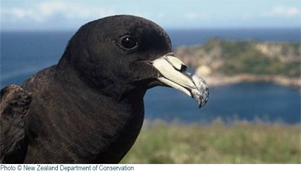Yvan Richard and colleagues have produced a report which assesses which New Zealand seabirds are most at risk from commercial fisheries. Their report is available on-line at the New Zealand Ministry of Fisheries' web site.
Extracts from the report's Executive Summary follow:
"We examined the risk of incidental mortality from commercial fishing for 64 seabird species in New Zealand trawl and longline fisheries. For each species, the risk was assessed by comparing the total number of birds potentially killed while fishing against the Potential Biological Removal (PBR) index. This index represents the amount of human-induced mortality a species can sustain without compromising its persistence.
"Amongst the 64 studied species, the black petrel (Procellaria parkinsoni) clearly stood out as the species the most at risk from commercial fishing activities within the New Zealand Exclusive Economic Zone. With an average number of potential annual fishing-related fatalities estimated to be almost 10 times higher than the PBR, our study suggests that this species should become the primary subject of more detailed research and management.
"Seven other species had a number of annual potential fatalities significantly exceeding the PBR, as the 95% confidence interval of their risk ratio was strictly above one: the grey-headed albatross, the Chatham albatross, the Westland petrel, the light-mantled albatross, the Salvin's albatross, the fleshfooted shearwater, and the Stewart Island shag.
"Small inshore fisheries, especially trawl fisheries targeting flatfish, and small bottom and surface fisheries, appeared to be associated with the greatest level of risk to species. This was due to a combination of low observer coverage, high effort, and overlap with the distributions of many seabird species in these fisheries. In these poorly observed fisheries, the risk is primarily associated with the lack of information. Of the species that had a risk ratio greater than one, the risk for four of them (grey-headed albatross, Westland petrel, Chatham albatross, and light-mantled albatross) was associated with a lack of observer coverage in inshore fisheries that overlap with the distribution of these birds."
Reference:
Richard, Y., Abraham, E.R. & Filippi, D. 2011. Assessment of the Risk to Seabird Populations from New Zealand Commercial Fisheries. Final Research Report for Ministry of Fisheries Projects IPA2009/19 and IPA2009/20. Wellington: Ministry of Fisheries. 66 pp.
The New Zealand Ministry of Fisheries and the Department of Conservation are currently producing a new Seabird Policy (click here).

John Cooper, ACAP Information Officer, 27 June 2011

 English
English  Français
Français  Español
Español